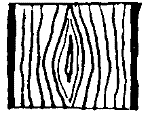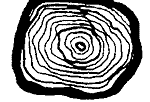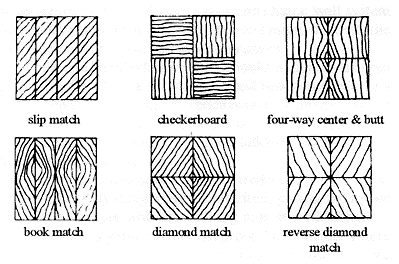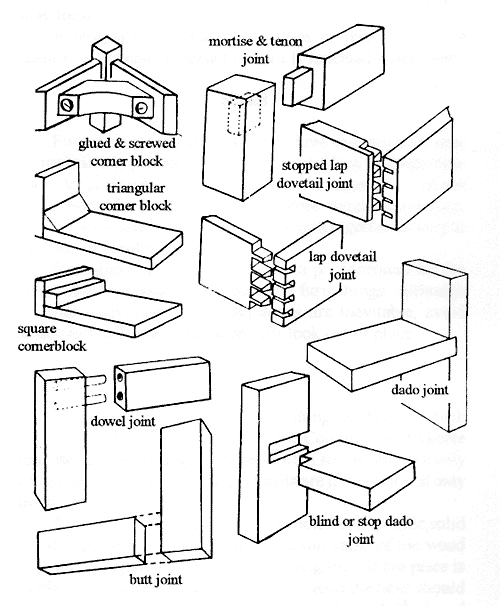This publication offers points to consider when buying various types of cabinetry chests, desks, bedsteads, tables, chairs, etc.
Adapted by Shirley M. Niemeyer, Extension Specialist, Interior Design/Home Furnishings
- Wood
- Wood joinery
- Safety
- Finishes
- Styles
- Labels
- Master Plan/Purchasing Considerations
- What To Remember When You Go Shopping
- Where to Look
Case goods is a term used to describe various types of cabinetry, chests, desks, bedsteads, tables and chairs.
Wood
Wood case goods may be solid wood, plywood, hardboard, particle board, veneer, "sem" and, in a few instances, paper. Furniture wood may be hard (walnut teak, mahogany, cherry, maple, birch, pecan, oak and' numerous exotics) or soft (pine, fir, redwood and spruce).Solid woods are used for legs, frames, rails, stretchers, corner posts and carved sections. Solid woods are strongest when cut and designed with the grain of the wood. Cross-grain designs are weaker. Moving from a damp to a dry climate may make solid wood split and shrink.
 with grain |  cross-grain |
Wide pieces of solid wood are rare. Even solid wood chest tops, table tops and chair seats are several pieces of solid wood that have been joined and glued together.
Solid wood has some advantages over other materials: carving can be done with a greater degree of fineness; chips, scratches or gouges expose like wood, so they are covered more easily; and refinishing a solid wood item does not present sanding or other repair problems.
Plywood
More than 90 percent of furniture made today contains some plywood. Plywood has some definite advantages over solid wood. Because plywood is made by gluing several thin layers of wood together with their grains at right angles, it often is stronger than solid wood. Large, flat surfaces, such as table and cabinet tops, and curved wood pieces often are made of plywood because it can be bent and molded. It is very strong as a result of its construction, and resists checking, splitting and warping.Plywood comes in a wide range of sizes and thicknesses. It usually is faced with thin veneer ranging in thickness from 1/32 inch to 1/10 inch. Plywood may be made with a variety of cores and ply materials.
Hardboard
Hardboard is made from refined wood fibers locked together with adhesives, steam and pressure. There are three types of hardboard: standard, tempered and service.Standard is strong and has good water resistance. It often is used in furniture construction.
Tempered hardboard has been treated chemically and with heat to increase its stiffness, hardness and finishing properties. It often is used in floors and dividers within drawers or cabinets, and is sometimes used as back panels for cabinets, bookcases and mirrors.
Hardboard may be smooth on both sides or smooth on one side, rough on the other. Hardboard comes in 1/16 inch to 3/4 inch thicknesses and panels of various sizes.
Particle Board
Particle board is composed of wood particles and adhesive. It can be formed by extrusion, mat-forming or flat-pressing.Densities vary from 30 to 50 pounds per cubic foot. Thicknesses vary from 1/8 inch to two inches and come in several panel sizes. Particle board has no grain, so it virtually is free of splitting, checking, shrinking and warping problems. Particle board often is used in place of plywood to construct large, flat surfaces, then finished with veneers or laminates. It also can be painted or enameled.
Veneer
Veneers were developed to make maximum use of rare, valuable woods. Veneering is not complicated, but it requires precision workmanship. Most domestic veneers are 1/28 inch thick, although some are 1/16 inch thick. Imported veneers usually are 1/60 inch thick. This layer of wood (flitch) is sliced from a log using one of five primary methods: rift cut, quarter slice, plain slice, one-half-round slice and rotary cut.

Extra-fancy veneers come from burl, crotch and butt, or stump, wood. Most veneer sheets are relatively small, so they have to be pieced together by matching similar grains and color tones. The most common matching techniques are book match, slip match, checkerboard, diamond match, reverse diamond match, and four-way center and butt match.
Exquisite veneer surfaces are made from inlay, intarsia and marquetry processes. These surfaces cost more than plain-veneered surfaces.

Sem Wood
"Sem" wood (short for serpentine and matching) is made by gluing together small pieces of hardwood suit able for furniture manufacture. Like solid wood, sem wood is used for exposed furniture parts.Joints in sem wood are computer-cut and glued together, leaving a glue line thickness of .001 of an inch or less. Joints are virtually invisible to the human eye.
This technique lets manufacturers use smaller trees that previously were not desirable in furniture production.
Paper
Paper and cardboard are other wood products with possibilities for furnishings, especially in low-cost furniture. Paper maché furniture has been produced periodically since at least the 17th century. Pieces at that time were small accessory type items. During the mid l0th century, however, many lightweight tables, chairs, smoking stands, etc., were made of paper maché. Today's paper and cardboard furniture features two extremes: the very simple, cardboard storage units and tables, and the designer-styled, modern chairs and tables. Some wicker-like furniture is made of Kraft-paper.
Plastic
Some solid wood carving has been replaced by cast plastic. Although almost indistinguishable from wood, the finish sometimes will wear away, revealing the tan plastic base underneath.
Wood joinery
Case goods should be constructed to hold up to their intended use. This includes joints, which should be smooth and tight. Glue and long staples may make joint construction tight without having to use standard joinery methods, but top-quality construction usually is done with standard wood joinery methods:
Hundreds of wood joints are used in furniture construction. Because joints must fit together two segments of something, they should be strong and attractive. Manufacturers must consider time and cost, so they often substitute lesser-quality joints in lower-cost furniture. Screws and dowels, mortise-and-tenon, or dovetail, are often used to fasten the best-made wood case goods. Staples or nails, found in lesser-quality pieces, may loosen and come out. Examine the total construction of a piece because prices tell little about quality.
Both center and side drawer glides are satisfactory as long as they are well-constructed and strong enough to support the drawer. The best-made furniture has dust panels between drawers to protect drawer contents. Drawers should fit to the back of the cabinet and have drawer stops so they won't pull out of the frame.
Test the drawers by opening and closing them. They should move effortlessly when you push or pull them from one side to the other.
Take the drawers out and examine them. They should be smooth and firm, not rough and wobbly. Drawer pulls should be comfortable and easy to hold onto.
The furniture frame should be constructed firmly with joints tightly fitted and glued, corner blocks where needed, and back panel firmly attached. The back panel should be finished for protection but need not be the same finish as the main piece.
Doors should be attached with hinges strong enough to support their weight. For large or heavy doors, full-length piano hinges are advised. Hinges may be exposed or hidden. All should work smoothly and effortlessly. Be sure doors open and close easily, fit well and do not sag.
Safety
Furniture should be safe to use. Test pieces for stability. Be especially alert to cantilevered shapes; tall, thin items; three-legged or pedestal-base tables and chairs; wall system pieces; drawer units in which top drawers might overturn the unit when opened; and furniture on casters.Cribs and bunkbeds especially should be purchased with an eye to safety. Check for side rails and headboards where a child's head might be caught (space between side rails should not exceed 2-3/8 inches); mattresses that are too small or too high for the frame; poorly designed ladders; hardware that doesn't work or comes off.
Sharp edges and corners can be treacherous for anyone but are especially dangerous for children, people with poor eyesight, and those who use walking aids or a wheelchair.
Furniture is generally not fireproof. So, consider where you will use the items you buy, and choose materials that are as firesafe as possible. Because wood and coal stoves commonly are used today, firesafe furniture is more important than it has been for several years.
Finishes
Furniture finishes vary with construction materials and styles. Fine wood furniture and other natural materials often are finished to emphasize their natural beauty. These finishes may be only on the surface or they may penetrate. Because surface finishes stay on the surface of the wood, they easily can be scratched or damaged. Penetrating finishes are absorbed by the wood, durable (if properly applied) and relatively simple to repair if damaged. Finishes protect a surface from soiling and wear.The finest finish is considered to be the mellow, handrubbed look for wood furniture. High-gloss finishes show fingerprints and are not easy to care for. Even the best contemporary painted or plastic finishes have a mellow sheen.
Commercial furniture manufacturers primarily use oil, lacquer and paint to finish wood furniture. They may stain the wood before oiling or lacquering. Stain may be used to match or change a color, to even or level a color, or cover a flaw or to emphasize grain.
Painted furniture may cost less or it may be a means of achieving fashion-colored items. House paint or enamel often is used on lesser-quality items while colored lacquer is used on higher-quality items. Epoxy resin paint or lacquer base develops a tough, durable skin nearly as rugged as plastic laminates.
Plastic laminate finishes commonly are found on table and chest tops. These may be Formica trademark, Micarta trademark, Textolite trademark, or a number of other trade names. Laminates may be clear, colored, designed or photographically finished and textured to look like another material. Laminated surfaces are strong and durable but do not hold up to repeated abrasion or excessive heat.
Plastic impregnated paper is used on some furniture surfaces. It usually is photographically finished to look like another material, and may be somewhat textured. Paper finishes look quite acceptable but are not as durable to abrasion, heat or heavy use. In moist or low-heat areas, paper may loosen.
Photographic finishes on plastics or paper easily are identified because the exact pattern is repeated indefinitely.
Styles
Furniture styles easily fall into three categories: classic or traditional; provincial or country; modern or contemporary. All of your furniture need not be the same style, but one style should be dominant. Other pieces should harmonize. Similar style categories usually work well together as long as they are of similar scale.Case goods should be scaled and proportioned for the space you have and the surrounding furnishings. Although unusual marketing trends and styles are inevitable, avoid selecting fad items. They soon will look out of place.
Labels
Guidelines for the home furnishings industry, which were established by the Federal Trade Commission, indicate that any tags and labels are to be written so consumers easily can understand them. Tags and labels are to be removed only by the consumer.If all exposed surfaces are constructed of a specific solid wood, the piece may be labeled with the name of the wood (e.g. solid maple, solid Honduras mahogany). If the piece is made with more than one type of solid wood the label should read: "selected hardwoods" or "selected softwoods birch and other selected hardwoods cherry and maple" or "solid cherry and solid maple"; or "solid maple top and fronts." If two specific woods are identified, the first one named is the dominant wood in the piece.
Labels for veneered furniture are to be done similarly. If veneer and solids are made of the same material, one of these methods is acceptable: "walnut solids and veneers"; "walnut-veneered construction." If a mix of woods has been used, labels might read: "teak veneers and hackberry solids"; "cherry veneers and solid hardwoods."
When manufactured wood products are used in furniture construction, the label merely may specify "wood products," or it may use the name of the material: "chipcore," "particle board," "hardboard."
When wood names are used to describe the color of a stain finish, grain design or other simulated finish applied to the exposed surfaces of furniture made of something other than the wood named, labels must clearly describe what the term is being used for. Cherry finish is not adequate. "Cherry stain finish," "walnut color," "oak finish on ash veneer" and "mahogany-grained plastic" all are acceptable.
Mahogany comes in many varieties. The term mahogany alone refers to the varieties of mahogany from the West Indies or Tropical Americas. The mahoganies may be prefixed by their place of origin: Costa Rican Mahogany, Honduras Mahogany. Mahogany of the genus Khaya must be prefixed by the term "African."
Philippine mahogany is not a true mahogany. It refers to seven non-mahogany woods and is only usable because of the length of time over which the term has been used. Those seven woods include: Bagtikan, Tanguile, Red or White Luan, Almon, Tiaong, and Mayapis. Labels for these products using the term mahogany must be prefixed by the word "Philippine."
Only black maple or sugar maple may be referred to using these terms: maple, hard maple, rock maple, birds-eye maple, Northern maple or Salem maple.
When exposed furniture surfaces or parts are made of metal or plastic that looks like wood, labels must clearly say so: oak-grained (metal/plastic) top; solid cherry top with (metal/plastic) front and sides; walnut-grained (steel/molded plastic) bookcase; imitation wood; simulated oak finish on (metal/plastic); and (metal/plastic) simulating wood.
Master Plan/Purchasing Considerations
Because case goods represent a sizable investment, purchase them carefully. Developing a master plan for your home will help you select pieces for long-term use. Spur-of-the-moment purchases are more apt to result in an uncoordinated array of things that never quite meet your needs. To prepare a master plan, consider the following:
- What do you want as an end result?
- How much do you have to spend? What is your budget for furnishings? Remember: It is unnecessary to purchase everything you want now.
- What do you most need? By when do you need what?
- Purchase the best quality your budget will permit.
- Select major pieces before investing in accessory items.
- Styles and materials can be mixed. What do you like?
- Avoid fads unless you have unlimited funds.
Select a reliable store with reliable salespeople. Find out what kinds of services the store offers and its policy on delivery. Furniture sales are usually in February, July and August, but check your locality.
Consider these alternatives when you're buying furniture:
- Are you purchasing for long- or short-term use? Cost and quality can differ greatly depending on this.
- Must you have new or would you consider used? Cost of used can be one-half (or less) that of new, but do you need to make repairs? If so, can you do the work or do you need to hire someone? Cost for repairs?
- Can you select a multi-functional-use piece (occasional tables with hidden storage, high/low tables, cabinets with pop-up storage for TV or other accessories, credenza/server/desk/buffet with storage for all uses, pier walls)?
- Do you want free-standing pieces or built-ins?
- Do you want something functional, decorative or for investment?
What To Remember When You Go Shopping
- Take your floor plan with measurements (width, height, depth of everything) and fixed items identified.
- Take color swatches of items you plan to use.
- Take pictures of things you like or dislike to help the salesperson.
- Identify your budget if that is a concern.
Where to Look
New: Furniture stores, interior design studios, department stores, catalogs (general, specialized), unfinished shops, kits, make-it-yourself plans.Used: Second-hand shops, Goodwill stores, newspaper/bulletin board ads, yard/garage sales, auctions, attics/barns/cellars, antique shops.
In buying used furniture, ask yourself:
- What is the style/color/finish?
- What is the table size?
- Does table have leaves/size/number?
- How many chairs? What style?
- If upholstered, what fabric/color/condition?
- Age of set?
- Condition of set?
- Price of set?
- Will owner deliver? Where located?
Similar pages: